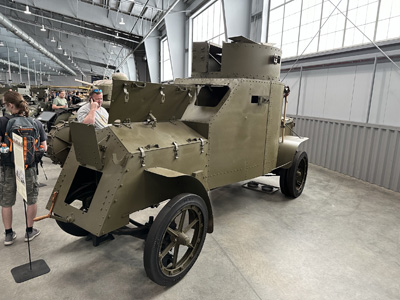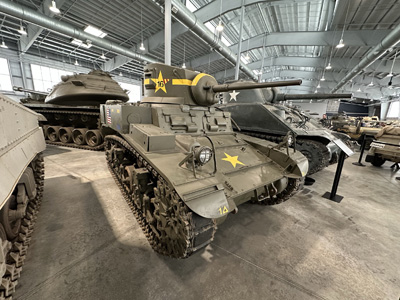Hal Jespersen’s Armor and Cavalry Collection Trip, Fort Benning, April 2023
This is my report of my trip to Fort Benning, Georgia, to attend the first open house of the US Army Armor and Cavalry Collection. The Armor School of my youth is no longer at Fort Knox, having moved to Benning a few years ago. The collection of armored vehicles has not been open to the public all of the time, both because they were relocating to a new facility and because of Covid. So I jumped at the chance to see their collection on the very first day it was open. (It will still not be generally accessible to the public for the time being—only future open houses. It is used actively for soldier training in the meantime.) This Sunday is the 75th anniversary of the US Army’s order establishing the “Armored Museum of the Armor School” at Fort Knox.
Friday, April 28 — to Columbus
I flew United Airlines to Atlanta and rented a car for the hundred mile drive to Columbus, Georgia. Columbus is a quaint small city on the Chattahoochee River which I had visited once before with a BGES tour.
Saturday, April 29 — Fort Benning
I started the day with a long walk on the Riverwalk, a delightful path that stretches for miles along the Chattahoochee. Then there was a big line of vehicles trying to get through the visitor lane into Fort Benning, and once I had my drivers license scanned by the MP, it was actually about 6 or 7 miles to get to the armor collection. One forgets how big these military installations are. I had quite a feeling of nostalgia driving through because it has been over 40 years since I have been on an army post.

The collection is in a large warehouse and there are well over 100 specimens of armored vehicles and weapons, focusing pretty heavily on the US, but also a number of German and British, and a smattering from other countries. The collection ranged from World War I up through the present, including some very rare prototype vehicles. It is an impressive collection, exceeding in my opinion that at Bovington in the UK (see my visit to that tank museum), although they have not yet invested in much museum-like infrastructure. Some of the tanks had placards that described their characteristics, but the vast majority had simple notecards with only the name of the tank. And there were no general displays talking about how tanks were developed and deployed, famous battles, etc. I talked to their Director, Len Dyer, and he said they certainly intend to beef up this aspect in the future, but they were rushing to make the collection available after their long absence. I happened to run into a guy visiting from the UK who works for the company Armortek and he suggested that this museum was like Bovington 30 years ago.
I am posting below photographs that I took of only a part of the collection. I did not bother with many of the wheeled vehicles or the artillery pieces. I also did not photograph every single one of the dozens of Sherman tank variants. For those who find these photographs less than interesting, follow this link to my videos from later in the day when the “Scouts in Action” did a live fire rehearsal for the biannual Gainey Cup cavalry squad competition.
There were a few highlights for me. First, I have never actually been up close to an M1 Abrams. (My tank experience in the Army of the 1970s was with M60A1s.) Here was an M1A2 SEP v3, the latest version. They also had an M2 Bradley infantry fighting vehicle, which is theoretically not that interesting, but I was impressed with how hulking big it was. I was nostalgic to see an M577 command vehicle; when I was the signal officer of a tank battalion I had two of these large armored vehicles in my platoon. There were prototypes of vehicles in the pre-M1, MBT70 program. And a bunch of rare heavy US tanks, including the monstrous T28 Superheavy, which had four tracks to carry its 95 tons. On the German side, there was a Tiger that had part of its sides sliced off so you could see inside. There was also a Tiger II (King Tiger) and the prototype Panther II, which was never produced.

































































































































Scouts in Action: Gainey Cup Rehearsal
The Gainey Cup is like a cavalry version of the best infantry squad competition they hold at Benning. It was about 6 miles away at the Red Cloud firing range and before we got into the bleachers, we had to sign liability waivers and were issued two forms of hearing protection, earplugs and big muffs; both were required. This was a rehearsal for the actual cup competition on Monday, so we got to see only a small number of soldiers. They started with helicopter rope dropping insertion onto the battlefield, advancing cautiously, and mortar firing on quite a distant target. Then two M1127 Stryker vehicles showed up and some of the guys jumped in and light machine guns started firing off at old vehicles a couple of kilometers in the distance. Next two M2 Bradleys arrived, firing their 25mm chain guns. And then two M1 Abrams started blasting away. Those guys were right in front of us and were therefore quite loud, even with the hearing protectors. The whole exercise lasted about a half an hour and was accompanied by narration as well as hearing the radio traffic between all of the parties involved.




Sunday, April 30 — Civil War Atlanta
The open house was two days long, but I did not see any reason to return for the second day because there was no formal program of any kind. So I amused myself with some Civil War traveling. I have never been to Jonesboro, the final significant battle in the Atlanta campaign, so I drove there, about 80 miles in the direction of Atlanta. I was quite disappointed that there is nothing there. There is a modest Confederate cemetery dedicated to Patrick Cleburne, but they had no parking that I could find. The town itself is nothing to speak of and everything was quite forested so I could not see much of the terrain.
My next stop was in Buckhead, north of Atlanta, where the new Atlanta History Center is located. The primary draw here is the Battle of Atlanta Cyclorama, which I have visited in the past in its previous location in Grant Park. There have been quite a number of changes. First, it has been beautifully renovated and is completely immaculate and impressive. However, the big change is that the original version featured a set of bleachers in the center that rotated around while a narrator talked about key moments in the battle as we faced the appropriate points. Now it is like the Gettysburg cyclorama, where you stand on a center platform and wander around. It is preceded by a 15 minute movie that describes creating the painting and all of the controversies and changes over the years. At no time do they talk much about the battle itself. An amusing anecdote is that when Clark Gable visited Atlanta in 1939 for the opening of Gone With the Wind, he remarked to the mayor that the only problem with the cyclorama was that he was not in it. So they added a dead Yankee body with his face.





Also at the history center is the restored steam engine, Texas, which pursued the General in the 1862 Great Locomotive Chase. (The latter is in the Kennesaw railroad museum.) And they have a rather large exhibit about the Civil War in general, which I found pretty decent and mostly error-free. Outside are the leafy and relaxing gardens, nice to wander through.




I wrapped up by driving to an airport hotel for my trip back early Monday.